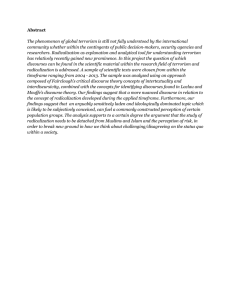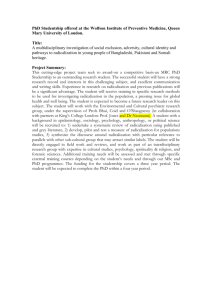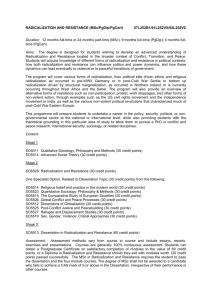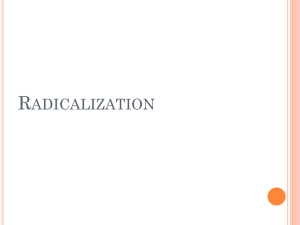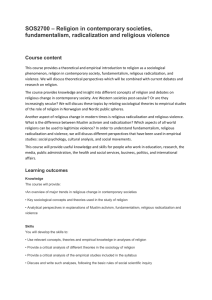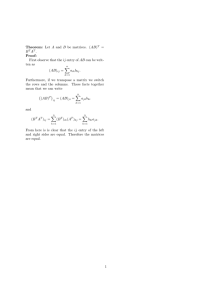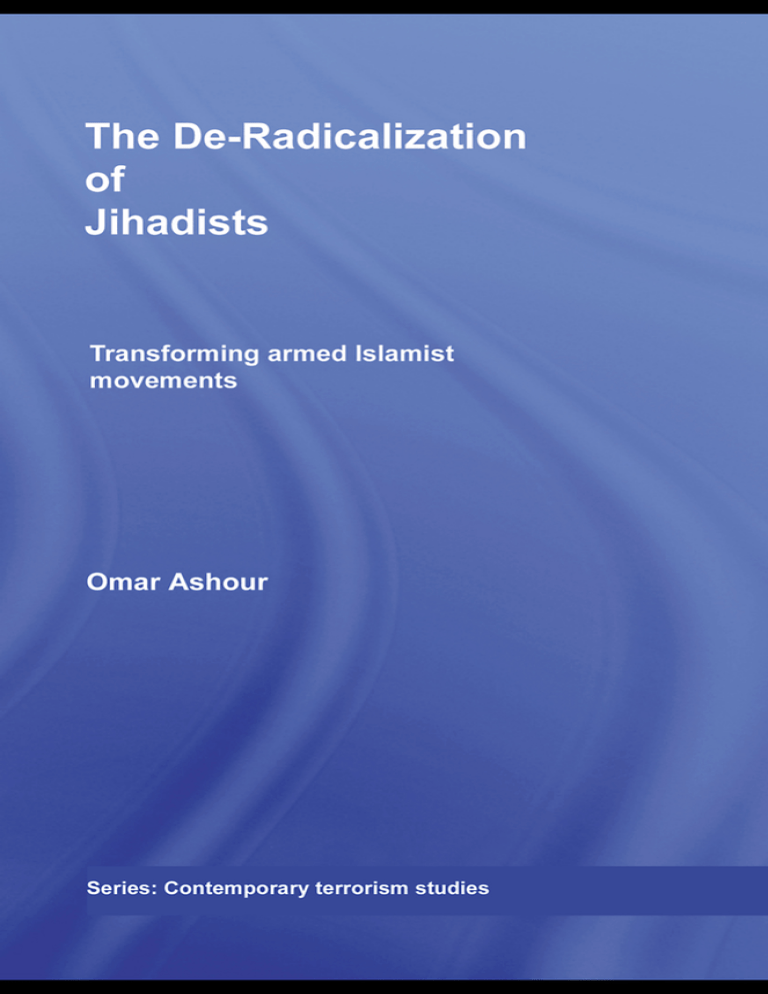
The De-­Radicalization of Jihadists
This book is the first detailed study of the causes of de-­radicalization in armed
Islamist movements. It is based on frontline research that includes interviews
with Jihadist leaders, mid-­ranking commanders and young sympathizers, as well
as former security and intelligence officers and state officials.
Additionally, it is also the first book to analyze the particular conditions under
which successful de-­radicalization can take place. The current literature on
Islamist movements attempts to explain two principal issues: their support of
violence (radicalization) and their changing attitudes towards democracy and
democratization (moderation). However, the reasons behind renouncing (behavioral de-­radicalization) and de-­legitimizing (ideological de-­radicalization) violence have not been evaluated to date. The author provides an in-­depth analysis
of the de-­radicalization processes of the Egyptian Muslim Brothers (1951–1973),
former allies of al-Qa‘ida, such as al-­Gama’a al-­Islammiyya (Islamic Group of
Egypt, 1997–2002) and al-­Jihad Organization (2007–present), as well as of
Algerian Islamist groups (1997–2000). The book also analyzes cases of de-­
radicalization failure.
The two questions that the book highlights and attempts to answer are Why?
and How? For example, why do radical Islamist militants revise their ideologies,
strategies and objectives and initiate a de-­radicalization process; and what are
the necessary conditions behind successful de-­radicalization? De-­radicalization
of Jihadists shows how a combination of charismatic leadership, state repression,
social interactions and selective inducements can ultimately lead Jihadists to
abandon “Jihad” and de-­legitimize violence.
This book will be of great interest to students of radical Islamist movements
and Islamic Studies, terrorism and political violence, security studies, and
Middle Eastern politics.
Omar Ashour is a Lecturer in Politics in the Institute of Arab and Islamic
Studies, University of Exeter. He has a PhD in International Relations from
McGill University in Canada.
Series: Contemporary terrorism studies
Understanding Terrorist Innovation
Technology, tactics and global trends
Adam Dolnik
The Strategy of Terrorism
How it works, why it fails
Peter Neumann and M.L.R. Smith
Female Terrorism and Militancy
Agency, utility and organization
Edited by Cindy D. Ness
Women and Terrorism
Female activity in domestic and international terror groups
Margaret Gonzalez-Perez
The Psychology of Strategic Terrorism
Public and government responses to attack
Ben Sheppard
The De-Radicalization of Jihadists
Transforming armed Islamist movements
Omar Ashour
The De-­Radicalization of
Jihadists
Transforming armed Islamist
movements
Omar Ashour
First published 2009
by Routledge
2 Park Square, Milton Park, Abingdon, Oxon OX14 4RN
Simultaneously published in the USA and Canada
by Routledge
270 Madison Ave, New York, NY 10016
Routledge is an imprint of the Taylor & Francis Group, an informa business
This edition published in the Taylor & Francis e-Library, 2009.
To purchase your own copy of this or any of Taylor & Francis or Routledge’s
collection of thousands of eBooks please go to www.eBookstore.tandf.co.uk.
© 2009 Omar Ashour
All rights reserved. No part of this book may be reprinted or reproduced or
utilized in any form or by any electronic, mechanical, or other means, now
known or hereafter invented, including photocopying and recording, or in
any information storage or retrieval system, without permission in writing
from the publishers.
British Library Cataloguing in Publication Data
A catalogue record for this book is available from the British Library
Library of Congress Cataloging in Publication Data
A catalog record for this book has been requested
ISBN 0-203-87709-8 Master e-book ISBN
ISBN10: 0-415-48545-2 (hbk)
ISBN10: 0-203-87709-8 (ebk)
ISBN13: 978-0-415-48545-6 (hbk)
ISBN13: 978-0-203-87709-8 (ebk)
Contents
List of illustrations
Foreword
Acknowledgments
List of abbreviations
1 A theory of de-­radicalization
vii
viii
xiii
xiv
1
Introduction 1
Definitions and typology 4
A typology of Islamists 7
How does de-­radicalization develop? 11
Method of investigation 17
The general structure of the book 18
2 The good, the bad and the ugly: moderation,
radicalization and de-­radicalization in Islamist
movements
19
On radicalization 19
On moderation 25
On de-­radicalization: a gap in the literature 30
Conclusion: what is new? 31
3 Historical overviews of de-­radicalization cases
Historical background of the Muslim Brothers 33
Historical background of the Islamic Group 45
Historical overviews of other armed Islamist movements 51
Conclusion 61
33
vi Contents
4 The untold story: the de-­radicalization of the armed
wings of the Muslim Brothers
63
5 The de-­radicalization of al-Qa‘ida’s allies: the Islamic
Group and al-­Jihad Organization
90
The de-­radicalization attempts: successes and failures 64
The first attempt (1951–1953) 64
The second attempt (1964–1965) 74
The third attempt (1969–1973) 80
Conclusion 86
The causes of de-­radicalization of the Islamic Group 91
The causes of de-­radicalization of al-­Jihad Organization 102
Al-­Jihad’s de-­radicalization: the effects on al-Qa‘ida 106
Conclusion 108
6 De-­radicalization in Algeria: successes and failures
110
Setting up the argument: ideology, controversial terms and missing
variables 111
The de-­radicalization process of the AIS 118
The de-­radicalization failure of the GIA 127
The further radicalization of the GSPC 131
Conclusion 134
7 A world without violent Jihad?
The findings in comparative perspectives 137
Research and policy implications 143
Notes
Bibliography
Index
136
146
181
198
Illustrations
Figures
1.1 Islamist typology and patterns of change
1.2 Structure, agency, process and feedback effects
11
12
Tables
1.1
3.1
4.1
5.1
6.1
6.2
7.1
Major trends in Islamism
Characteristics of armed Islamist movements
Summary of the variables affecting de-radicalization
The de-­radicalization of the IG and al-­Jihad
GIA leaders
De-­radicalization in Algeria
De-­radicalization case studies
11
62
88
108
128
134
141
Foreword
Nothing is more gratifying for an old teacher than to see one of his former students upholding the scholarly torch and going beyond his own footsteps to new,
untrodden research territory. This is the story of Omar Ashour’s book on the de-­
radicalization of Islamist groups in the early twenty-­first century.
When I researched Egypt’s Muslim militants in the late 1970s, hardly any
scholars since Richard Mitchell, in his book on the Society of the Muslim Brotherhood, had visited the subject in two decades. I published my early work in
IJMES in December 1980. The following two decades witnessed an avalanche
of writings and publications on what were invariably labeled as “Islamic awakening” or “Islamic Fundamentalism”, “resurgence”, “revival,” and “radicalization.” This trend was understandably reinforced by major events on the ground:
breaking out of the Iranian Islamic Revolution in 1979; and two years later by
the assassination of Egypt’s President Anwar Sadat by Muslim Jihadists.
Another upward turn came with the horrific events of the 9/11 bombing of New
York’s World Trade Center and the Pentagon Headquarter in Langley, Virginia,
allegedly by another more lethal Jihadist organization: the Afghanistan-­based al-­
Qa‘ida. The latter has displayed not only an unprecedented organizational capacity, but also a worldwide striking capability and multinational attraction for
recruits. Its lethal exploits occurred in such far apart locations as the Bali resort
island of Indonesia, the main commercial city of Casablanca in Morocco, a
Madrid railway station in Spain, and the London Underground.
The names of the al-­Qa‘ida leaders, the Saudi-­born Osama bin Laden and his
deputy, Egyptian-­born Ayman Zawahiri, soon would become household names.
Bloody events in Algeria, ascendance of Hezbollah in Lebanon and Hamas in
Palestine in the last two decades, have compounded both interest and fears in
many quarters.
Coinciding with the demise of the Soviet Bloc and the end of the Cold War
(1945–1990), many pundits shifted their fame, research interest and media
appeals to the emerging industry of the new enemy, “ Islamic Menace.” Western
media, academia, and policy “Think Tanks” have furiously raced to appropriate
a share in this new industry. Hundreds of conferences, seminars, and workshops
have been devoted to debating, understanding, containing, and combating
Islamic terrorism, “Clash of Civilization,” and Muslim Exceptionalism. Modes
Foreword ix
of international and domestic travel would undergo stringent regulations to
reduce risks and maximize passenger safety. Racial profiling and difficulties in
obtaining entry visas for citizens from Muslim-­majority countries became
commonplace.
The overwhelming media buzz, scholarly interest, and safety industry seem to
have overlooked a growing counter-­trend. Below the radar there was another
process unfolding – the de-­radicalization of some of the oldest and toughest
Muslim militant groups. Having been a student of the original subject myself, I
stumbled on the new counter-­trend by sheer accident: I was arrested, detained,
tried, convicted, and imprisoned for my own political activism, which had
nothing to do with Islamic radicalism.
My incarceration, between 2000 and 2003, took me back to the same prisons
in which various Muslim militants were serving their sentences. I had frequented
these same penal facilities twice before. The first was in the 1970s in my capacity as a field researcher, to which I have already referred above. The second time
was in the 1980s in my capacity as a Human Rights Defender – as I was the Secretary General of the Arab Human Rights Organization (AHRO) investigating
alleged complaints of human-­rights violations filed by or on behalf of imprisoned Muslim militants. The third time was as a fellow prison inmate in
June 2000.
Although in solitary confinement in Cell Block No. 6 of Torah Farm Prison
(TFP), I was surprised when I found one day a written message tucked in my
returned laundry, from one of the militants I had interviewed more than 20 years
earlier, welcoming me to the TFP, and offering sympathy, support and “help” on
behalf of himself and fellow “Brothers.” Initially, I was not sure what to make
of, or how to answer, the message, until I received a second message wondering
why I had not answered, with instructions of how and when to respond. Following the instructions proved to be the beginning of one of the most fascinating
dialogues and research ventures of my career as a Social Scientist. The dialogue
not only endured throughout my three years spent in TFP, but would also continue with other fellow Islamists outside prison after my acquittal on appeal by
the High Court in 2003.
It is in the course of this dialogue that it became increasingly clear that three
different Islamic groups had been going through an evolutionary process toward
being integrated into the societal mainstream. This is what Omar Ashour is
calling “de-­radicalization” in this book. The first to do so was Egypt’s Muslim
Brothers (MB), the mother of all modern Islamic movements. It was likely that
its de-­radicalization would become an “Ideal Type” in the Weberian sense. As
Omar notes, the MB, established by a charismatic young school teacher in 1928,
remained a peaceful, faith-­based, character-­building movement in its first two
decades (1928–1948), turned gradually militant in the following two (1948–
1968); and gradually de-­radicalized in the last four (1968–2008).
Such evolution in the case of the MB was a function of several factors, among
which were the ferocious reaction of the Egyptian state to its attempted use of
violence, the loss of popular sympathy especially in the presence of a ­charismatic
x Foreword
leadership such as that of Gamal Abdel Nasser (1954–1970), sober revision and
self-­criticism by the MB leaders of their own beliefs and practices. No less
important in this process has been the margins of regime tolerance under President Anwar el-­Sadat (1970–1981) and his successor Hosny Mubarak (1981–
2009). Although still treated as illegal, the MB members have been able to run
as “independents” or under the banner of other legal parties in local and national
elections. The fact that they have been active providers of social services to the
needy, especially in urban areas, seems to have helped significantly in increasing
their share of the popular vote from 2.0 percent in 1984 to 20 percent in 2005.
This has been the same general pattern for Islamists who opted to participate in
electoral politics in Turkey and Morocco.
The other militant Muslim groups that appeared in Egypt since the mid-­
1970s were invariably splinters from the MB, ostensibly in disapproval of their
elders’ moderation, which was interpreted as a “sell out” or as simply “historical fatigue.” Under a variety of names – such as Jihad, Repentance and Holy
Flight, Mohamed’s Youth, The Islamic Group – these groups started mostly on
university campuses, and later engaged Egyptian security forces in protracted
urban-­style guerilla warfare. They also targeted banks, tourist sites, ranking
Egyptian officials, members and institutions of Egypt’s Christian Copts, and
outspoken secular intellectuals. The climax of these confrontations was the
Luxor massacre of some 60 foreign tourists in November 1997. That horrific
event turned the Egyptian public en masse against armed Islamists, giving the
security forces a political carte blanche to eliminate all militants on the slightest
suspicion of being armed. This was indeed a turning point. The MB continued
to distance itself from any militant activity, disclaiming and condemning such
violent action conducted in the name of Islam. Many formerly militant groups
followed suit. New splits emerged between leaders and the rank-­and-file. A
clear fault line appeared between leaders abroad (in exile) and those at home.
Another fault line appeared between Islamists in prison and those who were
at large.
During my dialogue with the Islamist leaders in prison, one of the vexing
questions was why had the world made so much fuss about my case (known in
Egypt at the time as Ibn Khaldun Center, IKC) and yet had hardly raised a finger
about their plight, which was far worse as it included coerced disappearance,
torture, years of detention without trials, keeping many of them in prison long
after completing their sentences? I had no definitive answers to these question to
give them in prison, as I was a helpless inmate like them, with no access to the
outside world to inquire about this “stark differential treatment” of similar “cases
of conscience.” They were clearly disappointed in my lack of answers. They
came back with a request to speculate about why this might have been the case.
Among other things, I mentioned “tribalism, since I was one of the old Human
Rights Defenders”; so those like-­minded rose up in arms to defend one of them.
I mentioned that their image of intolerance and violence did not encourage the
Human Rights Community to give them priority in light of so many other, apparently more deserving cases.
Foreword xi
The question of what was wrong with their image would appropriate nearly a
year of the three-­year dialogue in TFR. They argued that they had changed significantly; that they now shared many of the common core values that the
Human Rights Community held dear. I retorted that even if they have indeed
changed in that direction, the world outside did not know; and even if so told, it
may not believe that the change was genuine. Ultimately it is both sustainable
words and deeds that will get some of the outside world to believe that former
Islamist militants have been, in fact, reformed. They asserted that they could
start with “words” while still in prison, while deeds would have to wait until
they were released. I commended them for this provisional response. In the following two years their leaders issued three volumes of “Muraja’at” (Revisions).
When 9/11 happened, they were shaken up by it, as they thought partly morally
responsible. This was in contrast to some of the initial denial –or worse, the
gloating – that others in prison and outside had expressed at seeing the mighty
U.S. being humiliated. The Islamist leaders’ reason for concern was that the 19
youngsters who committed that atrocious act may have been emulating elders
like the ones in dialogue with me. At that point, I became quite impressed, and
suggested they write a fourth volume expressing this candid assessment, which
they did.
I was acquitted on appeal in the spring of 2003. I immediately traveled abroad
for medical treatment of the nervous disorder caused by the harsh treatment
during my incarceration. It took four surgeries in the Johns Hopkins Hospital
before I was able to get out of my wheelchair. In 2004, I was honored by McGill
University Law School for my supposed defense of freedom and democracy in
Egypt and the Arab World. It is on this occasion that I ran into my old student
Omar Ashour in Montreal. As I was also asked to serve on the Canadian Board
of Rights and Democracy, I would see Omar regularly – at least three times a
year. Naturally, we talked at length about my prison experience, prospects of
democratization in the Middle East and his other research plans. I was pleasantly
surprised when he expressed his interest in writing a book on the topic of de-­
radicalization of Islamist Movements. I warned him, however, about the numerous “land mines” in the course of researching the topic in general, and if he were
to do fieldwork in particular. But he considered it a challenge, and forcefully
moved forward.
What he has produced is truly a pioneering work in an area of growing sociopolitical and geopolitical significance. It is obvious that non-­state actors have
become among the movers and shakers of international politics. And at the heart
of such groups are the faith-­based movements. A glance at the media headlines
any morning or evening in late 2008/2009 will invariably find the name of one
or more of these movements. The latest case in point at the writing of this foreword was the war in Gaza between Islamic Hamas and Israel.
While most are still radical, and hence problematic, to the post-­Westphalia
“State System” and/or “politics as usual,” Omar Ashour’s work points to promising directions of how to expedite the de-­radicalization of some, if not all, of
these movements. The ones he documented and analyzed in Egypt, Algeria, and
xii Foreword
other areas were involved in terrorism and conflicts that claimed the lives of as
many as 100,000 people. Yet now they are integral parts of the accepted
­sociopolitical landscape in their respective countries. Knowledge is always the
first step on the road to change. This book is a giant step on that road, and may
very well be one of the turning points of ushering the end of the “Radical Age of
Islamic Movements,” at least for a generation or more.
Saad Eddine Ibrahim
Professor, American University in Cairo and
Harvard University Founder, Ibn Khaldun Center
for Development Studies and Arab Organization
for Human Rights
Acknowledgments
Writing this book was a long and often arduous process. To all those who helped
me to reach the end, I owe my deepest and most heartfelt gratitude.
First, I would like to thank Rex Brynen, to whom I am very grateful for his
help and kind support. I also wish to thank Saad Eddine Ibrahim, for years of
mentoring and for always being a source of inspiration during both pleasant and
unpleasant times.
Thanks are due to Khalid Medani, Mark Brawley, Jean-­Louis Tiernan and
Robert Stewart for their insightful comments and editorial help. I would of
course like to emphasize that any errors in this book are my responsibility alone.
My deepest gratitude extends to my family. To my parents, whose support
was the main reason that I have been able to complete this book. To my sister
and brother, for their love and encouragement. To my grandmother, whose
weekly phone calls from Cairo were always a source of inspiration. To the spirit
of my grandfather, who nurtured in me the strong desire to understand and to
whom I never had a chance to say a final goodbye. And finally, to my uncles and
aunts, whose wisdom and advice are always guiding me.
This book is about ending violence. So these acknowledgments would not be
complete without referring to the people who lived through the violence and
have suffered under the repression of dictatorships and the terror of non-­state
actors. Though I do not mention them by name, I am very grateful to all those
who shared and trusted me with their experiences, their pains and their hopes –
some under conditions of almost unimaginable hardships.
To all of those, I am eternally indebted . . .
Abbreviations
AIS
AKP
ANP
FIDA
FIG
FIS
FV
GIA
GSPC
ICV
IG
IMU
IRP
LIDD
MB
MEI
MGH
MIA
OVPV
PJD
QICM
RB
Armée Islamique du Salut (Islamic Salvation Army) – Algeria
Adalet ve Kalkınma Partisi (Justice and Development Party) –
Turkey
Armée Nationale Populaire (People’s National Army) – Algeria
Front Islamique du Djihad Armé (Islamic Front for Armed Jihad)
– Algeria
Fighting Islamic Group (al-­Jama‘a al-­Islammiyya al-­Muqatila) –
Libya
Front Islamique du Salut (Islamic Salvation Front) – Algeria
Fighting Vanguards (Al-­Tali‘a al-­Muqatila) – Syria
Groupe Islamique Armé (Armed Islamic Group) – Algeria
Groupe Salafite pour la Prédication et la Combat (Salafi Group
for Preaching and Combat) – Algeria
Initiative for Ceasing Violence (Mubadarit Waqf al-­’Unf) –
Egypt
Islamic Group (al-­Gama‘a al-­Islammiyya) – Egypt
Islamic Movement of Uzbekistan (Harakati Islammii Uzbekistan)
– Uzbekistan
Islamic Renaissance Party (Hizbi Nahzati Islammii) – Tajikistan
League Islamique pour Da‘wa et Djihad (Islamic League for
Da’wa and Jihad) – Algeria
Muslim Brothers (al-­Ikhwan al-­Muslimun) – Egypt
Mouvement pour l’Etat Islamique (Movement for the Islamic
State) – Algeria
Milli Görüş Harekatı (National Outlook Movement) – Turkey
Mouvement Islamique Armé (Armed Islamic Movement) –
Algeria
Ordering Virtue and Preventing Vice
Parti de la Justice et du Développement (Justice and Development Party) – Morocco
al-Qa‘ida in the Islamic Countries of al-­Magreb (al-Qa‘ida fi
Bilad al-­Maghreb al-­Islami) – Algeria
al-­Rahman Brigade (Katibat al-­Rahman) – Algeria
Abbreviations xv
RG
RP
SCIRI
SO
SP
SR
SSI
UD
UTO
VT
WP
Religious Group (al-­Jama’a al-­Diniya) – Egypt
Refah Partisi (Welfare Party) – Turkey
Supreme Council for Islamic Revolution (al-­Majlis al- ’a’laa lil­Thawra al-­Islamiyya) – Iraq
Special Organization (al-­Tanzim al-­Sirri) – Egypt
Saadet Partisi (Felicity Party) – Turkey
Special Apparatus (al-­Nizam al-­Khass) – Egypt
State Security Investigations (Mabahith Amn al-­Dawla) – Egypt
Units Department (Qism al-­Wahadat) – Egypt
United Tajikistani Opposition (Itihadi Mu’arazati Tajikistan) –
Tajikistan
Vanguards of Triumph (Tala‘i‘ al-­Fattih) – Egypt
Wasat Party (Hizb al-­Wasat) – Egypt
1 A theory of de-­radicalization
Armed wings have dragged Islamist movements into undesired confrontations
with America and the West . . . those wings should be banned permanently.
(Nagih Ibrhaim, Ideologue of al-­Gama’a al-­Islamiyya, Egypt, 2007)
Introduction
In late 1951, Hassan al-­Hudaybi, the new General Guide of Jam’iyyat al-­Ikhwan
al-­Muslimin (Society of the Muslim Brothers – MB) in Egypt decided to dismantle the main armed wing of the Society that was known at the time as al-­
Nizam al-­Khass (Special Apparatus – SA). The leadership of al-­Hudaybi was
already being challenged, and the decision was extremely controversial. It thus
led to further factionalization and even internal violence within the Society.
Ultimately, it took approximately two decades for the leadership to dismantle the
SA completely. Since the early 1970s, the MB has abandoned violence against
national regimes, and has de-­legitimized and prohibited that type of violence by
ideological and theological arguments. Additionally, the leadership of the MB in
Egypt has also dismantled all of its armed units. These conditions indicate a successful, comprehensive de-­radicalization process that took place on the behavioral, ideological and organizational levels.
In a very similar but shorter process, al-­Gama’a al-­Islamiyya (Islamic Group
– IG) – the largest armed Islamist movement in Egypt during the 1980s and
1990s – declared a unilateral ceasefire in July 1997 that surprised observers, officials and even many IG members and commanders. The ceasefire declaration
contradicted the militant literature of the group, the previous vows of its leaders
to continue the armed struggle until it had toppled the Mubarak regime and the
increasingly violent tactics used by the IG affiliates since the late 1970s. In 2002,
the leadership of the IG not only dismantled its armed wings, but also renounced
its radical literature, published new books and replaced its curricula with those
of the relatively moderate Muslim Brothers (Zinah 2003, 16). Members of the
shura (consultative) council of the IG issued several books explaining its new
non-­violent ideology. As with the Muslim Brothers, this seemed to indicate a de-­
radicalization process that had taken place not only on the behavioral (strategic/
2 A theory of de-radicalization
tactical) level but also on the ideological level. By 2007, the IG’s de-­
radicalization process looked to have been consolidated: no armed operations
since 1999, no significant splits within the movement and around 25 volumes
authored by the IG leaders to support their new ideology with both theological
and rational arguments. Two of the volumes were critiques of al-Qa‘ida’s behavior (Zuhdi et al. 2002; 2003) and a third was a critique of the “clash of civilizations” hypothesis, arguing instead for cultural dialogue (Ibrahim et al. 2005,
225–247). The drafting of these volumes by the same movement that co-­
assassinated President Anwar al-­Sadat for signing the Egyptian–Israeli Peace
Treaty was a significant development. This process of de-­radicalization removed
more than 15,000 IG militants from the Salafi-­Jihadi1 camp currently led by
al-Qa‘ida.
In 2007, al-­Jihad Organization, the second largest armed organization in
Egypt, with strong ties to al-Qa‘ida, also initiated a de-­radicalization process.
The process is being led by the former emir (commander) of al-­Jihad (1987–
1993) and al-Qa‘ida’s ideologue, Dr. Sayyid Imam al-­Sharif (alias ‘Abd al-­Qadir
Ibn ‘Abd al-­’Aziz as well as Dr. Fadl). To recant his old views, al-­Sharif authored a new book entitled Document for Guiding Jihad in Egypt and the World.
In addition, al-­Sharif and other al-­Jihad commanders toured Egyptian prisons
between February and April 2007 to meet with their followers and discuss the
de-­radicalization process. That process has been only partially successful
however, as three factions within al-­Jihad still refuse to uphold it. These factions
also refuse to leave the Organization and one of them is in alliance with alQa‘ida. The process is thus still ongoing at the present time.2
In Algeria, similar de-­radicalizing transformations occurred in 1997. Like the
IG of Egypt, the self-­declared armed wing of the Islamic Salvation Front (FIS),3
known as the Islamic Salvation Army (AIS), declared a unilateral ceasefire. The
ceasefire led to disarmament and demilitarization processes that aimed for the
reintegration of the AIS members as well as other armed Islamist factions into
Algeria’s civil ranks. The demilitarization process included subgroups from the
notorious Armed Islamic Group (GIA) and the Salafi Group for Preaching and
Combat (GSPC).4 These groups and factions issued several communiqués to
explain and legitimize their decisions to dismantle their armed wings. Unlike the
Egyptian groups, however, the Algerian groups did not produce any ideological
literature to reconstruct a new ideology.
The phenomenon of “de-­radicalization” is not only confined to the previously
mentioned countries. In the 2000s, it took place in several other Muslim-­majority
countries, albeit on a smaller scale than in Egypt and Algeria. These de-­
radicalization cases include Libyan, Saudi, Yemeni, Jordanian, Tajik, Malaysian
and Indonesian armed Islamist groups, factions and individuals. Additionally,
the Egyptian de-­radicalization processes had international repercussions. For
example, the transformations of the IG have influenced several leaders from the
British Islamic Liberation Party and caused them to abandon the Party’s radical
ideology (Nawaz 2007, 6). In Libya, factions from the Fighting Islamic Group
(FIG) modeled their de-­radicalization process after that of the Egyptian IG and
A theory of de-radicalization 3
recently published several books in which they ideologically and theologically
de-­legitimized violence against national regimes (al-­Tawil 2006, 7; Libya al-­
Youm 2008, 4). In Saudi Arabia, government-­sponsored al-­Munasaha (Advising) Programs, as well as interventions from independent Islamic scholars,
succeed in de-­radicalizing mainly individuals and small groups who allegedly
supported or were loosely linked to al-Qa‘ida Network (Howaidy 2007, 6). In
Tajikistan, the Islamic Renaissance Party (IRP) that led the United Tajikistani
Opposition (UTO) in the civil war of 1992–1997, again led the UTO into a
fragile peace agreement with the Tajik regime. Similar to the IG in Egypt and
the AIS and other armed groups in Algeria, the IRP called for “Jihad” in 1992
and then for a ceasefire, a compromise and a peaceful resolution of the conflict
in 1997.
Despite the fact that the aforementioned armed Islamist movements, which
used to engage in terrorist acts, have shown remarkable behavioral and ideological transformations towards non-­violence and despite that the “de-­
radicalization” processes of these movements had removed tens of thousands of
former militants from the ranks of al-Qa‘ida’s supporters and acted as disincentives for would-­be militants, there is not one single detailed book on the causes
of de-­radicalization processes. Nor there is a comprehensive study about the conditions under which de-­radicalization can be successful. This is the case in spite
of the great interest in explaining Islamism and the huge volume of literature
produced after the 9/11 attacks.
Generally, the literature on Islamist movements attempts to explain two
issues: their support of violence (radicalization) and their changing attitudes
towards democracy and democratization (moderation). The literature addressed
and debated the causes of radicalization since the late 1970s. As for moderation,
a smaller number of works have addressed the causes of that process as it is a
relatively recent development.5 More importantly, the reasons behind renouncing
(behavioral de-­radicalization) and de-­legitimizing (ideological de-­radicalization)
violence were not analyzed before in the literature. None have developed a
theoretical account of the causes of the de-­radicalization process within armed
Islamist movements. As such, this book will address crucial lacunae in the literature on Islamism, security and counterterrorism studies as the first detailed study
of the causes of de-­radicalization of specific armed Islamist movements, based
on frontline research that includes personal, media and archival interviews with
Islamist leaders, mid-­ranking commanders, grassroots, young sympathizers,
Islamist movements’ specialists, former security and intelligence officers and
state officials. Additionally, it will also be the first detailed study that analyzes
the particular conditions under which successful de-­radicalization can take place.
To explain these changes within movements that have long glorified violent
struggle and upheld continuity, the main question that this book attempts to
answer is: why do radical Islamist militants revise their ideologies, strategies and
objectives and initiate a de-­radicalization process?6 In other words, can militant
Islamist radicals turn into relatively peaceful groups that accept the “other” and,
if yes, under what conditions?
4 A theory of de-radicalization
In order to answers these research questions, this chapter will begin by providing definitions of key terms and concepts as well as a typology of Islamists
and their ideologies in the following section. Thereafter, a theoretical framework
will be developed in an attempt to explain the causes of de-­radicalization processes. Following this, several case studies will be undertaken. The first case is
that of the Muslim Brothers in Egypt between 1951 and 1973. The second and
the third cases are those of the Islamic Group, and the related al-­Jihad Organization. The fourth case is that of the AIS and the affiliated militias in Algeria.7
Also, Algeria provides two cases where de-­radicalization was attempted but was
ultimately unsuccessful. These cases are those of the GIA and the GSPC and
they are analyzed in the sixth chapter as well. Finally, in the conclusion, the
book will provide a comprehensive theoretical framework that explains the
causes of de-­radicalization of armed Islamist movements as well as some policy
implications.
Definitions and typology
General definitions
In this section, the terms that are used throughout the book are defined. Also, a
typology of Islamist groups and ideologies is provided.
Islamist groups that the book discusses are sociopolitical movements that
base and justify their political principles, ideologies, behaviors and objectives on
their understanding of Islam8 or on their understanding of a certain past interpretation of Islam.9 Islamist groups can be distinguished under the broad categories of moderate and radical.
By a moderate Islamist group, I mean an Islamist movement that ideologically accepts, at minimum, electoral democracy10 as well as political and ideological pluralism, and that aims for gradual social, political and economic
changes. Behaviorally (tactically and strategically), moderate groups accept the
principle of working within the established state institutions, regardless of their
perceived legitimacy, and shun violent methods to achieve their goals. Moderate
Islamists could also be called reformists, pluralists or modernists.
By contrast, radical Islamist groups are those movements that ideologically
reject democracy as well as the legitimacy of political and ideological pluralism.
They also aim for revolutionary social, political and economic changes and
refuse to work within the established state institutions. Radical Islamist movements can use violent and/or non-­violent methods to achieve their goals. Radical
Islamists could also be called revolutionaries, extremists or exclusivists.
To highlight and explain nuanced ideological and behavioral changes within
relatively moderate groups like the MB in Egypt, I shall divide moderate Islamists into electoral and liberal sub-­grouping. Electoral Islamists are the ones who
accept the Schumpeterian definition of democracy,11 tend to emphasize majoritarianism,12 and are reluctant to accept minority rights in general13 and those they
consider to be “illegitimate” minorities in particular.14 Electoral Islamists tend to
A theory of de-radicalization 5
be the majority within Islamist movements and the most popular Islamist movements fit into this sub-­group. 15 On the other hand, liberal Islamists accept liberal
democracy with its elements of constitutional liberalism and provisions for protecting minority rights. Within the larger Islamist movement, liberal Islamists
are a very rare breed, and indeed could even be perceived as a theoretical
extreme with little or no concrete instantiations.16 However, interviews done
with the Turkish Justice and Development Party (AKP) and the Egyptian WP
leaders suggest that they follow a relatively liberal trend.17
Regarding the radicals, three main distinctions should be made to highlight
nuanced ideological and behavioral differences and changes. The first distinction
is between violent and non-­violent radicals.18 This book is mainly focused on
violent radicals, as the concept of de-­radicalization19 is primarily concerned with
changing the attitudes of once-­armed Islamist movements towards violence.
The second is between the groups that perceive violent combat as means to an
end and those groups who perceive it as a “sacred” end in and of itself. I refer to
the former as pragmatic militants20 and to the latter as extremist militants.
Examples of the former are the AIS in Algeria and the IRP in Tajikistan.21
Examples of the latter are the Egyptian al-­Jihad, the IG before their ideological
transformations, the Algerian GIA and the global al-Qa‘ida.22
The third distinction is between the radicals who ideologically legitimize and
practice violence against civilians and unarmed persons (terrorism) and the ones
who ideologically prohibit, and practically refrain from, that behavior. To the
extent of my knowledge, all extremist militants ideologically legitimize and practice violence against civilians, whereas pragmatic militants tend to shun that path.23
Processes of change within Islamist movements
Radicalization, de-­radicalization and moderation are processes of relative
change within Islamist movements that can occur on the ideological and/or the
behavioral levels, evenly or unevenly across issue areas. The three processes are
centered on the changes in the stated positions and views of Islamist leaders and
groups on violence and democracy relative to their positions in the past.
Radicalization
Radicalization is a process of relative change in which a group undergoes ideological and/or behavioral transformations that lead to the rejection of democratic
principles (including the peaceful alternation of power and the legitimacy of
ideological and political pluralism) and possibly to the utilization of violence, or
to an increase in the levels of violence,24 to achieve political goals.
De-­radicalization
De-­radicalization is another process of relative change within Islamist movements, one in which a radical group reverses its ideology and de-­legitimizes the
6 A theory of de-radicalization
use of violent methods to achieve political goals, while also moving towards an
acceptance of gradual social, political and economic changes within a pluralist
context. A group undergoing a de-­radicalization process does not have to ideologically abide by democratic principles, whether electoral or liberal, and does
not have to participate in an electoral process.25 De-­radicalization is primarily
concerned with changing the attitudes of armed Islamist movements toward violence, rather than toward democracy. Many de-­radicalized groups still uphold
misogynist, homophobic, xenophobic and anti-­democratic views.26
As distinct from the ideological level, de-­radicalization can occur on the
behavioral level only. On that level, de-­radicalization means practically abandoning the use of violence to achieve political goals without a concurrent process
of ideological de-­legitimization of violence. De-­radicalization can occur in only
one of the two levels.
Finally, there is also a third level of de-­radicalization. Following the declaration of ideological and/or behavioral de-­radicalization by the leadership of an
armed group(s), there is usually the challenge of organizational de-­
radicalization: the dismantlement of the armed units of the organization, which
includes discharging/demobilizing their members without splits, mutiny or internal violence.
Several types of de-­radicalization correspond to the previously mentioned
levels: comprehensive de-­radicalization refers to a successful de-­radicalization
process on the three levels (ideological, behavioral and organizational). The
Egyptian cases represent comprehensive de-­radicalization well as two large
Egyptian organizations underwent that process successfully: the armed wings of
the MB (1969–1973) and the IG (1997–2002).27
Substantive de-­radicalization entails a successful process of de-­radicalization
on both the ideological and behavioral levels, but not on the organizational level
(usually a failure on that level is followed by splits, factionalization and internal
organizational conflict, and/or the marginalization of the de-­radicalized leadership). An example of substantive de-­radicalization is the case of the Egyptian al-­
Jihad which is discussed in the fifth chapter.28
A third type of de-­radicalization is pragmatic de-­radicalization which refers
to a successful behavioral and organizational de-­radicalization process, but
without an ideological de-­legitimization of violence. The Algerian AIS,29 discussed in the sixth chapter, is an example of an organization that underwent this
type of de-­radicalization.
Moderation
Finally, moderation is a process of relative change within Islamist movements
that is mainly concerned with the attitudes of these movements towards democracy. Moderation can take place on two levels: on the ideological level, the key
transformation is the acceptance of democratic principles, most importantly the
legitimacy of pluralism and the peaceful alternation of power. On the behavioral
level, the key transformation is participation in electoral politics (if allowed).

